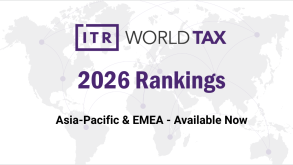The most notable development on the compliance enhancement front is the Jiangsu Provincial Tax Bureau's (JSTB) pioneering of a new profit monitoring mechanism for MNEs that will likely be rolled out nationwide in the near future. In tandem with this, the audit focus has shifted towards taxpayers exploiting the Chinese market, whilst making significant royalty or service payments to overseas affiliates.
Being an active proponent of the anti-BEPS initiatives, China has been working hard to enhance its tax transparency agenda and dispute resolution mechanisms. China was a first mover on the introduction of country-by-country (CbC) report filing obligations and it has committed to issuing formal interpretative guidance in the coming months.
On the dispute resolution front, we see a surge in China's efforts to resolve mutual agreement procedures (MAPs) with numerous competent authorities (CA) meetings with treaty partners being conducted and/or planned despite the persistent shortage of resources on the part of the SAT. The concerns that the MAPs would compromise China's ability to process the backlog of advance pricing arrangements (APA) has to a large degree faded, as many of the pending APAs are being added to the CA's agenda. This shows China's intention to cater to the growing demands of advance certainty by the taxpayers in the wake of anti-BEPS actions around the world.
Enhancing transfer pricing compliance and shifting of the audit focus
April 2018 saw the release of a new profit monitoring mechanism by the JSTB as part of the SAT's initiative to strengthen transfer pricing compliance activities on MNE taxpayers. The key feature of the programme is that selected taxpayers will be constantly monitored and ranked on a risk matrix based on multiple quantitative and qualitative criteria. It is expected that the mechanism will be implemented nationwide. To this end, the JSTB recently organised a seminar, attended by approximately 150 MNEs operating in the Jiangsu province, as well as advisers, to elucidate the new profit monitoring mechanism.
The main thrust of the profit monitoring mechanism is to enhance risk and compliance management oversight, aided by big data analysis. Instead of targeting all taxpayers that engage in cross-border related-party transactions, the authorities would selectively classify companies according to provinces, cities and districts, for clearer identification of "high risk" entities for constant monitoring that would likely result in swifter and targeted regulatory actions.
Extensive information gathering for big data analysis
To enable successful implementation, the tax authorities have launched a risk assessment framework that involves extensive tax and transfer pricing qualitative and quantitative information gathering. The annual contemporaneous transfer pricing documentation, which has detailed disclosure requirements under a revised regulation issued two years ago, forms one of the sources of information to effectuate the profit monitoring mechanism. Other information sources such as group annual reports, CbC reports, cross-government departmental data exchange, securities analyst reports, general news reports, etc., make up a comprehensive data source for the tax authorities. The information gathered focuses on basic business conditions, related-party transaction data, functional profile information, group information, detailed industry conditions, value chain information, etc. — all information would be harvested and inputted into the tax authorities' IT systems as part of a big data analysis.
Profiling of taxpayers on a risk matrix
The analysis churned out from the data would then be used by the authorities to conduct tax risk and compliance assessments on MNE taxpayers. The tax risk assessment focuses on group overall tax planning arrangements and intercompany transactions that are deemed complex, while the compliance assessment focuses on the degree of compliant disclosures of relevant information. Using both dimensions of the assessment framework, the authorities would classify the MNE taxpayers on a risk matrix based on qualitative and quantitative criteria.
Integral to the risk framework assessment, the Chinese tax authorities are expected to continually focus on the Chinese entities' contribution to the MNE's value chains and therefore the Chinese entities' share of profits. Two key elements of the assessment include:
The emphasis on the consistency between the functional profiles of the entities along the value chains and the profit attributed to these entities; and
Chinese market factors that contribute to the value creation process throughout the value chain.
To this end, it would not be a surprise for the Chinese tax authorities to request as much data as possible (it could be either through the CbC reports or other additional data request) to enable them to assess the reasonableness of profits earned by the Chinese entities.
Engagement between tax authorities and taxpayers likely to increase
High-risk taxpayers identified through the risk assessment framework should expect to receive warning notices, and it would likely result in taxpayers proactively engaging with the authorities to address the risk issues, such as performing transfer pricing adjustments voluntarily. Taxpayers that do not take any actions would remain high on the risk matrix and may eventually be subject to formal special tax investigations. It is expected that the new monitoring mechanism will lead to more dialogue between taxpayers and the tax authorities.
The increased engagement between taxpayers and tax authorities will likely result in a less confrontational audit environment. On the flip side, the constant monitoring of profit levels of MNE taxpayers by the tax authorities may exert pressure on taxpayers to meet the expectations of the tax authorities on a continuous basis.
While the reduction in investigations is a welcome sign of a maturing Chinese transfer pricing regime, the extensive information request may prove challenging for MNEs, more so for those with a multi-faceted supply chain and with complex IT systems that could not readily satisfy the authorities' request for data, especially considering China's 10-year enquiry window for transfer pricing adjustments. The increased expectations of the tax authorities on obtaining quality information with the contemporaneous documentation, as well as with subsequent information requests, would inevitably increase the compliance costs for taxpayers.
Audit focus is shifting
Hand in hand with the introduction of the compliance programme outlined above, a new trend is emerging, whereby the number of formal transfer pricing audits are declining, resulting in a shift of focus in the audits carried out. The decline probably stems from the Chinese tax authorities' efforts in creating a more communicative and cooperative compliance environment for MNEs. The current audits appear to be focused on taxpayers exploiting the Chinese market. In particular, greater scrutiny is expected on taxpayers who pay a significant amount of royalties and/or service fees to overseas related parties, despite having a largely domestic supply chain (e.g. buying, making and selling in China).
Such an audit focus is in line with the Chinese view that market access-related benefits, whether in the form of market premium or the contribution by the Chinese entity in promoting the products in China, should be captured in the taxable profits of the Chinese entity to reflect the importance of such market features or functions. Royalty and service fees, which are usually justified by the contribution from overseas related parties, are being challenged in audits as disproportional or downright inappropriate. The critical issue is whether the underlying intangibles or centralised functions are truly as valuable in the Chinese market as claimed, especially vis-à-vis strategic market features, such as local purchasing power, and the efforts and responsibilities of the Chinese entity.
On the other hand, companies that focus on production for overseas markets, which were primary audit targets for a long time, are less often challenged by the Chinese tax authorities.
China's transparency and international cooperation agenda
MAP and APA trend
China has been active in promoting the transparency and international cooperation agenda whilst gradually implementing measures such as multilateral exchange of CbC reports, with the UK, Germany and France in the first wave of activated CbC exchange relationships.
In the meantime, China is among the jurisdictions that committed to implement the OECD's BEPS minimum standards. A critical aspect of the minimum standards related to Action 14 is the peer review process, where the effectiveness and efficiency of a jurisdiction's MAP are assessed by its peer jurisdictions. While China's MAP regime had not yet been analysed after the third round of stage 1 peer reviews released in March 2018, the OECD guidance released in October 2016 provides that stage 1 peer reviews of all 44 countries that committed to the minimum standards should start before the end of 2018.
The SAT has been tackling the large number of MAP cases as matter of priority – market intelligence indicates that a number of pending MAP have been reactivated with the aim of reaching an expedited solution. Year to date, we also see a large number of MAPs being resolved, albeit in some cases through a pragmatic approach, focused on maximising the benefits of eliminating double taxation for the long run. On the APA front, it is expected that the enhanced process introduced by the 2016 legislation will contribute to the programme's faster resolution and effectiveness, as the number of applications continues to increase. The expedited resolution of MAPs also enhance the SAT's capacity to process the growing number of APAs, including the ones that saw limited progress in the past few years. Another welcome development is that the SAT has increased resources to deal with the MAP/APA at the central level, whilst local bureaux also seem to be devoting more resources to dispute resolution as a result of the combination of the former two-system tax bureaux at the local level.
Final thoughts
China is taking significant steps to harness technological developments and bring public governance to the 21st century. The Chinese tax authorities have been rapidly ramping up their use of big data analytics for tax risk assessment and audit targeting.
Taxpayer-related data sources available are anything but scarce: from transfer pricing disclosure forms, contemporaneous documentation, audit information collection, as well as data from other governmental bodies such as the Ministry of Commerce and State Administration of Foreign Exchange. The SAT is making significant investments in technology, including high capacity IT systems, advanced software applications and data warehousing capabilities to build an effective control system which integrates all industries, tax types and taxpayers in a single platform.
As a result, audit activity and the way taxpayers engage with tax authorities will change substantially. With greater resources devoted to desktop audits, field investigations will likely become less frequent but more incisive and effective. At the same time, as the tax function moves up in the value chain and becomes clearly strategic, taxpayers will need to invest in compliance systems and resources to ensure that going forward they can keep pace with the ever increasing demands from the tax office.
Cheng Chi |
|
|---|---|

|
Partner KPMG China 1 East Chang An Avenue, 8th floor, Oriental Plaza Beijing 100738 +86 10 8508 7608 Cheng Chi is the head of KPMG global transfer pricing services for China and Hong Kong SAR. Cheng has led many transfer pricing and tax efficient supply chain projects in Asia and Europe, involving advance pricing arrangement negotiations, cost contribution arrangements, pan-Asian documentation, controversy resolution, global procurement structuring, and headquarters services recharges for clients in the industrial market including the automobile, chemical, and machinery industries, as well as the consumer market, logistic, communication, electronics and financial services industries. In addition to lecturing at many national and local training events organised by the Chinese tax authorities, Cheng has provided technical advice on a number of recent transfer pricing legislative initiatives in China. A frequent speaker on transfer pricing and other matters, his analyses are regularly featured in tax and transfer pricing publications around the world. Cheng has been recommended as a leading transfer pricing adviser in China by the Legal Media Group. Cheng started his transfer pricing career in Europe with another leading accounting organisation, covering many of Europe's major jurisdictions while based in Amsterdam before returning to China in 2004. |
Rafael Triginelli Miraglia |
|
|---|---|

|
Senior manager KPMG China 1266 Nanjing West Road, 25th Floor, Plaza 66, Shanghai 200040 +86 21 2212 3176 Rafael Triginelli Miraglia is a senior tax manager with the global transfer pricing team of KPMG China and is a member of the firm's BEPS centre of excellence. His practice focuses on design and implementation of TP systems, business restructuring advice, value chain analysis and planning and outbound investments. Rafael is a law graduate (Universidade Federal de Minas Gerais, Brazil, 2004) and has also obtained a master's of laws (PUC-MG, Brazil, 2008) and an LLM in advanced studies in international tax law (International Tax Centre, Leiden University, the Netherlands, 2011). He is a TP lecturer at Leiden University and has taught courses in tax and constitutional law at PUC/MG and customs law at UNA/MG. Rafael has been a member of the Brazilian Bar Association (Ordem dos Advogados do Brasil) since 2005. Before joining KPMG China, Rafael worked between 2011 and 2015 as a tax associate with a global law firm in the Netherlands and, before that, as head of tax with a Brazilian law firm. |
Choon Beng Teoh |
|
|---|---|

|
Senior manager KPMG China 1266 Nanjing West Road, 25th Floor, Plaza 66, Shanghai 200040 +86 21 2212 4527 Choon Beng Teoh is a senior tax manager with the global transfer pricing team of KPMG China. Choon has experience in multi-jurisdictional planning studies, dispute resolution, value chain analysis and restructuring of operating models, as well as leading and managing global TP documentation projects. His client portfolio includes top-tier multinational companies across a variety of industries including the pharmaceutical, retail, and IT industries. He also occasionally co-authors articles on China-related TP topics for publications. Choon graduated with a law degree from the London School of Economics and is a chartered accountant with the Institute of Chartered Accountants in England and Wales. Before joining KPMG China, Choon practised in another leading accounting organisation in London in the area of international tax and TP. |









